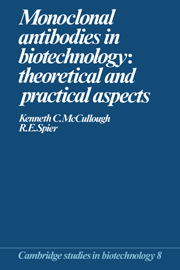Book contents
- Frontmatter
- Contents
- Acknowledgements
- 1 Introduction: the immune response
- 2 Making hybridomas (hybridoma technology)
- 3 Factors affecting successful hybridoma production
- 4 Selection of monoclonal antibody-secreting hybridoma cell lines
- 5 The large-scale production of monoclonal antibodies in vitro
- 6 In conclusion: the diversity in application of monoclonal antibodies and hybridoma technology
- References
- Index
4 - Selection of monoclonal antibody-secreting hybridoma cell lines
Published online by Cambridge University Press: 23 November 2009
- Frontmatter
- Contents
- Acknowledgements
- 1 Introduction: the immune response
- 2 Making hybridomas (hybridoma technology)
- 3 Factors affecting successful hybridoma production
- 4 Selection of monoclonal antibody-secreting hybridoma cell lines
- 5 The large-scale production of monoclonal antibodies in vitro
- 6 In conclusion: the diversity in application of monoclonal antibodies and hybridoma technology
- References
- Index
Summary
The production of monoclonal antibodies can be divided into a number of phases. (i) Immune splenocytes are fused with myeloma cells, and the resultant hybridomas are selected and adapted to growth in tissue culture. (ii)The hybridoma media (culture supernatants) are tested for the presence of antibody. (iii) Positive cultures are ‘weaned off’ feeder cells and, when fully adapted to growth in vitro,are cloned. (iv) Growing colonies of hybridoma cells are tested for secretion of antibody specific for the appropriate antigen, and positive cultures expanded (by growth and passage) and recloned. (v) Of these ‘re-clones’, those secreting the highest relative quantities of antibody (relative to the cell concentration) are selected for expansion and eventual storage. Chapters 2 and 3 dealt in detail with the preparation and passage of hybridoma cultures, and the conditions required for successful hybridoma production. This chapter will describe the methods for detecting antibody in hybridoma cultures, and the procedures of isolating monoclonal hybridomas (cloning).
The antibody-detecting assays will be described in approximate order of frequency of use in reports of hybridoma technology, and only the major assays will be discussed in detail. Other procedures will be mentioned, but the assays described in detail are those which should prove most applicable to hybridoma technology.
The three most commonly reported methods of cloning hybridoma cells will be described; the theoretical and practical advantages and disadvantages will be discussed.These procedures are cloning established hybridomas by limit dilution, isolation of colonies from the ‘masterplate’ (plate used for seeding the fusion mixture) – micromanipulation – and isolation of colonies in semi-solid ('sloppy') agar. A more recent adaptation, that of cloning hybridoma cells immediately after fusion, will also be described.
- Type
- Chapter
- Information
- Monoclonal Antibodies in BiotechnologyTheoretical and Practical Aspects, pp. 185 - 264Publisher: Cambridge University PressPrint publication year: 1990



